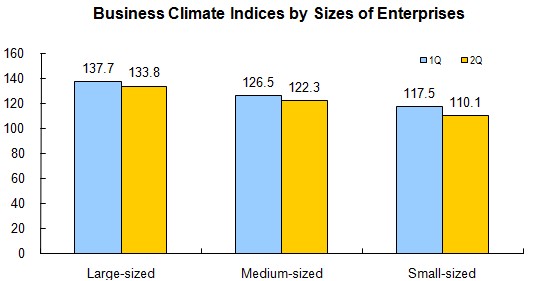National Business Climate Survey results showed that the business climate index (BCI) was 120.6 in the second quarter of 2013, decreased 5.0 points quarter-on-quarter, but still significantly higher than the critical value 100, and enterprises were still running in the prosperity interval. Of which, the current BCI that reflected the current state of business climate was 117.0, down by 2.0 points quarter-on-quarter; the expected BCI that reflected the anticipation of future business climate was 123.0, down by 6.9 points quarter-on-quarter. In the second quarter, the entrepreneur expectation index (ECI) was 117.0, down by 5.4 points quarter-on-quarter.
In terms of enterprises profit level, 73.8% of enterprises showed that the profit status in second quarter was at a "normal" or "better than normal" level, slightly increased 0.1 percentage point over that in the first quarter.
In terms of order status of industrial enterprises, 78.7 percent of enterprises showed that the order status in second quarter was at a "normal" or "better than normal" level, decreased 2.1 percentage points over that in the first quarter.
Survey results showed that the profit status and the order status were normal generally, the business climate is expected to remain a steady running state in the next quarter.

In terms of different industries, the rank of BCIs followed by the information transmission, software and IT services industry, construction, industry, wholesale and retail trade, social services, real estate, transportation, storage and postal industry, accommodation and restaurants was 136.8, 128.9, 125.0, 121.0, 114.6, 113.2, 110.7, 82.9 respectively. Except for accommodation and restaurants, the BCIs of other industries were all above the critical value. As compared with the results of the first quarter , the BCIs of information transmission, software and IT services industry, construction, industry, wholesale and retail trade, social services, real estate, transportation, storage and postal industry went down by 3.8, 5.5, 6.7, 3.9, 8.0, 2.1 and 3.1 points respectively, that of accommodation and restaurants rose by 3.1 points.

In terms of sub-branches of the industry, the BCIs of production and distribution of electricity, heating power, gas and water, manufacturing, and mining and quarrying was 137.3, 126.9 and 88.9 points, respectively. Of which, the industries with high prosperity from high to low in descending order were pharmaceutical, tobacco, beverage, food, the BCIs were above 140. The industry with low prosperity was steel and petroleum, the BCI were in a recession interval (the sentiment index is less than 100). As compared with the results of the first quarter, the prosperity levels of waste resource utilization, steel, petroleum, chemical raw material and chemical products, motor vehicles, non-ferrous metal, manufacture of special-purpose machinery dropped a lot, that of manufacture of fabricated metal products rose slightly.
In terms of different types of registration, the BCIs of state-owned enterprises, collective-owned enterprises, joint-stock cooperative enterprises, joint ventures, limited liability companies, cooperation limited, private enterprises, enterprises with funds from Hong Kong, Macao, and Taiwan, and foreign funded enterprises was 126.0, 109.5, 111.7, 111.8, 116.6, 129.5, 112.5, 124.1 and 124.0 points respectively in the second quarter, and all stayed above the critical value. As compared with the results of the first quarter, the BCIs of joint-stock cooperative enterprises, limited liability companies, private enterprises, cooperation limited, state-owned enterprises, enterprises with funds from Hong Kong, Macao, and Taiwan, collective-owned enterprises, joint ventures, and foreign funded enterprises dropped back 11.4, 6.0, 5.8, 4.2, 4.0, 3.8, 3.3, 2.7 and 2.5 points respectively.
In terms of the sizes of enterprises, the BCIs of large, medium and small-sized enterprises were 133.8, 122.3 and 110.1, respectively, all above the critical value, but down by 3.9, 4.2 and 7.4 points quarter-on-quarter, respectively.

In terms of different regions, the BCIs of eastern, central and western regions stood at 121.5, 122.1 and 115.4, respectively, all above the critical value, but down by 4.0, 5.5 and 7.2 points quarter-on-quarter, respectively.

Annotations:
1. Explanatory Notes
The business climate index is comprehensively reflects the economic situation and the expected direction, through out by the good or bad judgments on the business situation from the entrepreneurs from the business climate survey. The range of BCI is between 0-200, 100 as the critical value, when the index is greater than 100, reflecting the business climate state is good and optimistic, the more close to 200 the higher the level of optimism; less than 100, reflect the state of the business climate is poor and pessimistic, closer to 0 reflect deeper pessimistic.
2. Statistical Coverage
The survey covers eight sectors: industry, construction, wholesale and retail trade, transportation, storage and postal services, hotel and catering industry, information transmission, software and IT services, real estate, and social services. Each industry is according to the scale of the proportion of a sample.
3. Survey Methods
Samples were selected by adopting the sampling methods of stratified, probability proportional to size (PPS). The national total sample size were 21,000 enterprises.
4. Survey Contents
Survey involved in the business running, enterprises operation, profitability, employment, investment, financing, inventory and other production and management problems.
5. Calculation Methods
The business climate index = 0.4×Current BCI +0.6×Expected BCI
Current BCI = the proportion of good by the answer from the responsible persons in charge of the enterprise operating conditions in the current quarter - poor proportion of +100
Expected BCI = the proportion of good by the answer from the responsible persons in charge of the enterprise operating conditions in the next quarter - poor proportion of +100
6. Classification of Eastern, Central and Western Regions
Eastern regions including Beijing, Tianjin, Hebei, Liaoning, Shanghai, Jiangsu, Zhejiang, Fujian, Shandong, Guangdong, Hainan; central regions including Shanxi, Jilin, Heilongjiang, Anhui, Jiangxi, Henan, Hubei, Hunan; western regions including Inner Mongolia, Guangxi, Chongqing, Sichuan, Guizhou, Yunnan, Tibet, Shaanxi, Gansu, Qinghai, Ningxia, Xinjiang.





